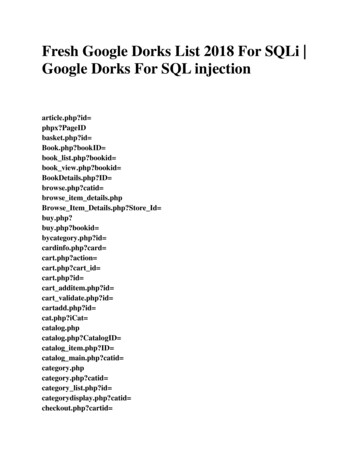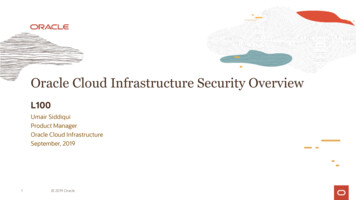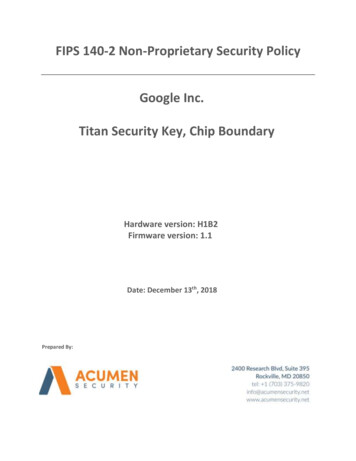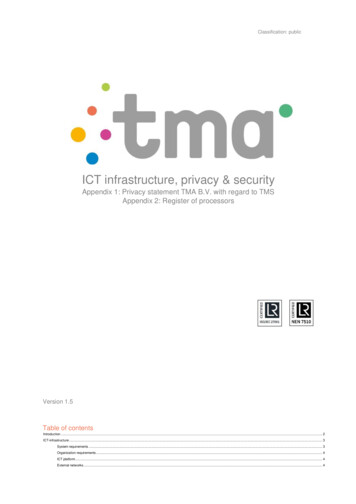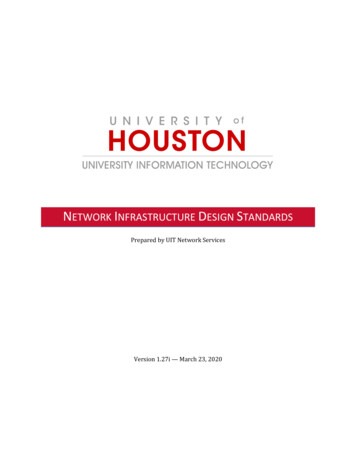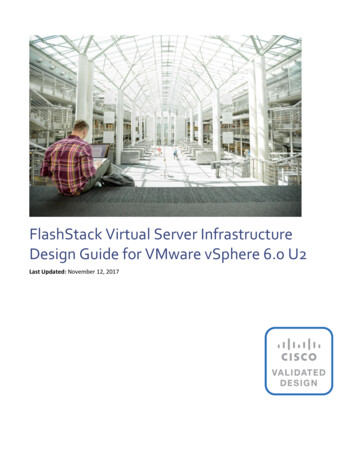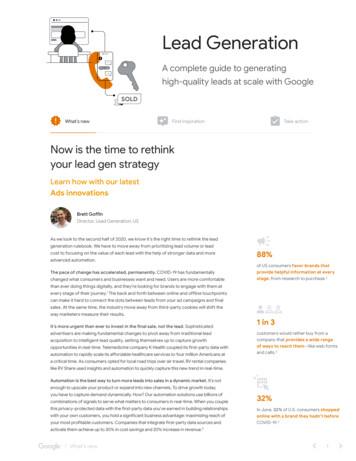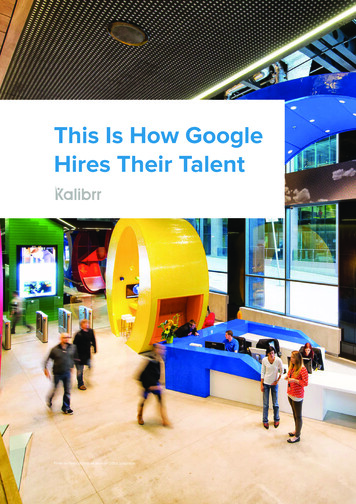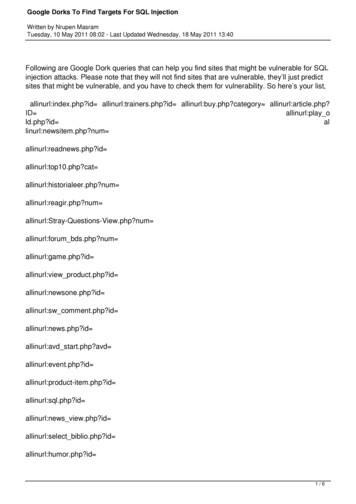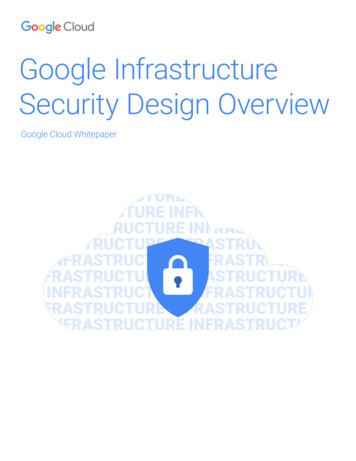
Transcription
Google InfrastructureSecurity Design OverviewGoogle Cloud Whitepaper
Table of ContentsIntroduction2Secure Low Level Infrastructure3Secure Service Deployment4Secure Data Storage7Secure Internet Communication8Operational Security9Security of Physical PremisesHardware Design and ProvenanceSecure Boot Stack and Machine IdentityService Identity, Integrity, and IsolationInter-Service Access ManagementEncryption of Inter-Service CommunicationAccess Management of End User DataEncryption at RestDeletion of DataGoogle Front End ServiceDenial of Service (DoS) ProtectionUser AuthenticationSafe Software DevelopmentKeeping Employee Devices and Credentials SafeReducing Insider RiskIntrusion DetectionSecuring the Google Cloud Platform (GCP)11Conclusion13Additional Reading13The content contained herein is correct as of January 2017, and represents the status quo as of the time it was written.Google’s security policies and systems may change going forward, as we continually improve protection for our customers.
CIO-level summary Google has a global scale technical infrastructure designed to provide securitythrough the entire information processing lifecycle at Google. This infrastructureprovides secure deployment of services, secure storage of data with end userprivacy safeguards, secure communications between services, secure andprivate communication with customers over the internet, and safe operationby administrators. Google uses this infrastructure to build its internet services, including bothconsumer services such as Search, Gmail, and Photos, and enterprise servicessuch as G Suite and Google Cloud Platform. The security of the infrastructure is designed in progressive layers starting fromthe physical security of data centers, continuing on to the security of thehardware and software that underlie the infrastructure, and finally, the technicalconstraints and processes in place to support operational security. Google invests heavily in securing its infrastructure with many hundreds ofengineers dedicated to security and privacy distributed across all of Google,including many who are recognized industry authorities.1
IntroductionThis document gives an overview of how security is designed into Google’stechnical infrastructure. This global scale infrastructure is designed to providesecurity through the entire information processing lifecycle at Google. Thisinfrastructure provides secure deployment of services, secure storage of datawith end user privacy safeguards, secure communications between services,secure and private communication with customers over the internet, and safeoperation by administrators.Google uses this infrastructure to build its internet services, including bothconsumer services such as Search, Gmail, and Photos, and enterprise servicessuch as G Suite and Google Cloud Platform.We will describe the security of this infrastructure in progressive layers startingfrom the physical security of our data centers, continuing on to how the hardwareand software that underlie the infrastructure are secured, and finally, describingthe technical constraints and processes in place to support operational security.Google Infrastructure Security LayersOperational SecurityIntrusion DetectionReducing Insider RiskInternet CommunicationGoogle Front EndSafe EmployeeDevices & CredentialsSafe SoftwareDevelopmentDoS ProtectionStorage ServicesEncryption at restDeletion of DataUser IdentityAuthenticationLogin Abuse ProtectionService DeploymentAccess Managementof End User DataEncryption of InterService CommunicationInter-Service AccessManagementHardware InfrastructureSecure Boot Stack andMachine IdentityHardware Design andProvenanceSecurity of PhysicalPremisesService Identity,Integrity, IsolationFigure 1.Google InfrastructureSecurity Layers:The various layers of securitystarting from hardwareinfrastructure at the bottomlayer up to operational securityat the top layer. The contentsof each layer are described indetail in the paper.2
Secure Low Level InfrastructureIn this section we describe how we secure the lowest layers of ourinfrastructure, ranging from the physical premises to the purpose-built hardwarein our data centers to the low-level software stack running on every machine.Security of Physical PremisesGoogle designs and builds its own data centers, which incorporate multiplelayers of physical security protections. Access to these data centers is limited toonly a very small fraction of Google employees. We use multiple physicalsecurity layers to protect our data center floors and use technologies likebiometric identification, metal detection, cameras, vehicle barriers, andlaser-based intrusion detection systems. Google additionally hosts some serversin third-party data centers, where we ensure that there are Google-controlledphysical security measures on top of the security layers provided by the datacenter operator. For example, in such sites we may operate independentbiometric identification systems, cameras, and metal detectors.A Google data centerconsists of thousandsof server machinesconnected to a localnetwork. Both theserver boards and thenetworking equipmentare custom designedby Google.Hardware Design and ProvenanceA Google data center consists of thousands of server machines connected to alocal network. Both the server boards and the networking equipment arecustom-designed by Google. We vet component vendors we work with andchoose components with care, while working with vendors to audit and validatethe security properties provided by the components. We also design customchips, including a hardware security chip that is currently being deployed on bothservers and peripherals. These chips allow us to securely identify andauthenticate legitimate Google devices at the hardware level.Secure Boot Stack and Machine IdentityGoogle server machines use a variety of technologies to ensure that they arebooting the correct software stack. We use cryptographic signatures overlow-level components like the BIOS, bootloader, kernel, and base operatingsystem image. These signatures can be validated during each boot or update.The components are all Google-controlled, built, and hardened. With each newgeneration of hardware we strive to continually improve security: for example,depending on the generation of server design, we root the trust of the boot chainin either a lockable firmware chip, a microcontroller running Google-writtensecurity code, or the above mentioned Google-designed security chip.Each server machine in the data center has its own specific identity that can betied to the hardware root of trust and the software with which the machinebooted. This identity is used to authenticate API calls to and from low-levelmanagement services on the machine.Google has authored automated systems to ensure servers run up-to-dateversions of their software stacks (including security patches), to detect and3
We use cryptographicauthentication andauthorization at theapplication layer forinter-servicecommunication.This provides strongaccess control at anabstraction level andgranularity thatadministrators andservices can naturallyunderstand.diagnose hardware and software problems, and to remove machines fromservice if necessary.Secure Service DeploymentWe will now go on to describe how we go from the base hardware and softwareto ensuring that a service is deployed securely on our infrastructure. By ‘service’we mean an application binary that a developer wrote and wants to run on ourinfrastructure, for example, a Gmail SMTP server, a BigTable storage server, aYouTube video transcoder, or an App Engine sandbox running a customerapplication. There may be thousands of machines running copies of the sameservice to handle the required scale of the workload. Services running on theinfrastructure are controlled by a cluster orchestration service called Borg.As we will see in this section, the infrastructure does not assume any trustbetween services running on the infrastructure. In other words, the infrastructureis fundamentally designed to be multi-tenant.Service Identity, Integrity, and IsolationWe use cryptographic authentication and authorization at the application layerfor inter-service communication. This provides strong access control at anabstraction level and granularity that administrators and services cannaturally understand.We do not rely on internal network segmentation or firewalling as our primarysecurity mechanisms, though we do use ingress and egress filtering at variouspoints in our network to prevent IP spoofing as a further security layer. Thisapproach also helps us to maximize our network’s performance and availability.Each service that runs on the infrastructure has an associated service accountidentity. A service is provided cryptographic credentials that it can use to proveits identity when making or receiving remote procedure calls (RPCs) to otherservices. These identities are used by clients to ensure that they are talking tothe correct intended server, and by servers to limit access to methods and datato particular clients.Google’s source code is stored in a central repository where both current andpast versions of the service are auditable. The infrastructure can additionally beconfigured to require that a service’s binaries be built from specific reviewed,checked in, and tested source code. Such code reviews require inspection andapproval from at least one engineer other than the author, and the systemenforces that code modifications to any system must be approved by theowners of that system. These requirements limit the ability of an insider oradversary to make malicious modifications to source code and also provide aforensic trail from a service back to its source.4
We have a variety of isolation and sandboxing techniques for protecting aservice from other services running on the same machine. These techniquesinclude normal Linux user separation, language and kernel-based sandboxes,and hardware virtualization. In general, we use more layers of isolation for riskierworkloads; for example, when running complex file format converters onuser-supplied data or when running user supplied code for products like GoogleApp Engine or Google Compute Engine. As an extra security boundary, we enablevery sensitive services, such as the cluster orchestration service and some keymanagement services, to run exclusively on dedicated machines.Inter-Service Access ManagementThe owner of a service can use access management features provided by theinfrastructure to specify exactly which other services can communicate with it.For example, a service may want to offer some APIs solely to a specific whitelistof other services. That service can be configured with the whitelist of theallowed service account identities and this access restriction is thenautomatically enforced by the infrastructure.The owner of aservice can useaccess managementfeatures provided bythe infrastructure tospecify exactly whichother services cancommunicate with it.Google engineers accessing services are also issued individual identities, soservices can be similarly configured to allow or deny their accesses. All of thesetypes of identities (machine, service, and employee) are in a global name spacethat the infrastructure maintains. As will be explained later in this document, enduser identities are handled separately.The infrastructure provides a rich identity management workflow system forthese internal identities including approval chains, logging, and notification. Forexample, these identities can be assigned to access control groups via a systemthat allows two party-control where one engineer can propose a change to agroup that another engineer (who is also an administrator of the group) mustapprove. This system allows secure access management processes to scale tothe thousands of services running on the infrastructure.In addition to the automatic API-level access control mechanism, theinfrastructure also provides services the ability to read from central ACL andgroup databases so that they can implement their own custom, fine-grainedaccess control where necessary.Encryption of Inter-Service CommunicationBeyond the RPC authentication and authorization capabilities discussed in theprevious sections, the infrastructure also provides cryptographic privacy andintegrity for RPC data on the network. To provide these security benefits to otherapplication layer protocols such as HTTP, we encapsulate them inside ourinfrastructure RPC mechanisms. In essence, this gives application layer isolationand removes any dependency on the security of the network path. Encryptedinter-service communication can remain secure even if the network is tapped ora network device is compromised.5
Services can configure the level of cryptographic protection they want for eachinfrastructure RPC (e.g. only configure integrity-level protection for low valuedata inside data centers). To protect against sophisticated adversaries who maybe trying to tap our private WAN links, the infrastructure automatically encryptsall infrastructure RPC traffic which goes over the WAN between data centers,without requiring any explicit configuration from the service. We have started todeploy hardware cryptographic accelerators that will allow us to extend thisdefault encryption to all infrastructure RPC traffic inside our data centers.Access Management of End User DataA typical Google service is written to do something for an end user. For example,an end user may store their email on Gmail. The end user’s interaction with anapplication like Gmail spans other services within the infrastructure. So forexample, the Gmail service may call an API provided by the Contacts service toaccess the end user’s address book.We have seen in the preceding section that the Contacts service can beconfigured such that the only RPC requests that are allowed are from the Gmailservice (or from any other particular services that the Contacts service wantsto allow).This, however, is still a very broad set of permissions. Within the scope of thispermission the Gmail service would be able to request the contacts of any userat any time.Since the Gmail service makes an RPC request to the Contacts service on behalfof a particular end user, the infrastructure provides a capability for the Gmailservice to present an “end user permission ticket” as part of the RPC. This ticketproves that the Gmail service is currently servicing a request on behalf of thatparticular end user. This enables the Contacts service to implement a safeguardwhere it only returns data for the end user named in the ticket.To protect againstsophisticatedadversaries who maybe trying to tap ourprivate WAN links, theinfrastructureautomatically encryptsall infrastructure RPCtraffic which goes overthe WAN betweendata centers.The infrastructure provides a central user identity service which issues these“end user permission tickets”. An end user login is verified by the central identityservice which then issues a user credential, such as a cookie or OAuth token, tothe user’s client device. Every subsequent request from the client device intoGoogle needs to present that user credential.When a service receives an end user credential, it passes the credential to thecentral identity service for verification. If the end user credential verifies correctly,the central identity service returns a short-lived “end user permission ticket” thatcan be used for RPCs related to the request. In our example, that service whichgets the “end user permission ticket” would be the Gmail service, which wouldpass it to the Contacts service. From that point on, for any cascading calls, the“end user permission ticket” can be handed down by the calling service to thecallee as a part of the RPC call.6
Service AService BCall B.get info()Service Config:Name AAccount a serviceEncryption ofinter-servicecommunicationB.get info()Caller ID a serviceCallee ID b serviceINFRASTRUCTUREIdentityProvisioning byService ownerAutomaticmutualauthenticationAccess Rule Config:Only account ‘a service’can access B.get info()Service Config:Name BAccount b serviceFigure 2.Service Identity andAccess Management:The infrastructure providesservice identity, automaticmutual authentication,encrypted inter-servicecommunication andenforcement of accesspolicies defined by theservice owner.Enforcementof Serviceowner’saccess policySecure Data StorageUp to this point in the discussion, we have described how we deploy servicessecurely. We now turn to discussing how we implement secure data storage onthe infrastructure.Encryption at RestGoogle’s infrastructure provides a variety of storage services, such as BigTableand Spanner, and a central key management service. Most applications atGoogle access physical storage indirectly via these storage services. The storageservices can be configured to use keys from the central key management serviceto encrypt data before it is written to physical storage. This key managementservice supports automatic key rotation, provides extensive audit logs, andintegrates with the previously mentioned end user permission tickets to link keysto particular end users.Performing encryption at the application layer allows the infrastructure to isolateitself from potential threats at the lower levels of storage such as malicious diskfirmware. That said, the infrastructure also implements additional layers ofprotection. We enable hardware encryption support in our hard drives and SSDsand meticulously track each drive through its lifecycle. Before a decommissionedencrypted storage device can physically leave our custody, it is cleaned using amulti-step process that includes two independent verifications. Devices that donot pass this wiping procedure are physically destroyed (e.g. shredded)on-premise.7
Deletion of DataDeletion of data at Google most often starts with marking specific data as“scheduled for deletion” rather than actually removing the data entirely. Thisallows us to recover from unintentional deletions, whether customer-initiated ordue to a bug or process error internally. After having been marked as “scheduledfor deletion,” the data is deleted in accordance with service-specific policies.When an end user deletes their entire account, the infrastructure notifiesservices handling end user data that the account has been deleted. Theservices can then schedule data associated with the deleted end user accountfor deletion.The Google Front Endensures that all TLSconnections areterminated usingcorrect certificates andfollowing best practicessuch as supportingperfect forward secrecy.Secure Internet CommunicationUntil this point in this document, we have described how we secure services onour infrastructure. In this section we turn to describing how we securecommunication between the internet and these services.As discussed earlier, the infrastructure consists of a large set of physicalmachines which are interconnected over the LAN and WAN and the security ofinter-service communication is not dependent on the security of the network.However, we do isolate our infrastructure from the internet into a private IPspace so that we can more easily implement additional protections such asdefenses against denial of service (DoS) attacks by only exposing a subset ofthe machines directly to external internet traffic.Google Front End ServiceWhen a service wants to make itself available on the Internet, it can register itselfwith an infrastructure service called the Google Front End (GFE). The GFEensures that all TLS connections are terminated using correct certificates andfollowing best practices such as supporting perfect forward secrecy. The GFEadditionally applies protections against Denial of Service attacks (which we willdiscuss in more detail later). The GFE then forwards requests for the serviceusing the RPC security protocol discussed previously.In effect, any internal service which chooses to publish itself externally uses theGFE as a smart reverse-proxy front end. This front end provides public IP hostingof its public DNS name, Denial of Service (DoS) protection, and TLS termination.Note that GFEs run on the infrastructure like any other service and thus have theability to scale to match incoming request volumes.Denial of Service (DoS) ProtectionThe sheer scale of our infrastructure enables Google to simply absorb many DoSattacks. That said, we have multi-tier, multi-layer DoS protections that furtherreduce the risk of any DoS impact on a service running behind a GFE.8
After our backbone delivers an external connection to one of our data centers, itpasses through several layers of hardware and software load-balancing. Theseload balancers report information about incoming traffic to a central DoS servicerunning on the infrastructure. When the central DoS service detects that a DoSattack is taking place, it can configure the load balancers to drop or throttletraffic associated with the attack.At the next layer, the GFE instances also report information about requests thatthey are receiving to the central DoS service, including application layerinformation that the load balancers don’t have. The central DoS service can thenalso configure the GFE instances to drop or throttle attack traffic.User AuthenticationThe sheer scale of ourinfrastructure enablesGoogle to simply absorbmany DoS attacks. Thatsaid, we have multi-tier,multi-layer DoSprotections that furtherreduce the risk of anyDoS impact on a servicerunning behind a GFE.After DoS protection, the next layer of defense comes from our central identityservice. This service usually manifests to end users as the Google login page.Beyond asking for a simple username and password, the service alsointelligently challenges users for additional information based on risk factorssuch as whether they have logged in from the same device or a similar locationin the past. After authenticating the user, the identity service issues credentialssuch as cookies and OAuth tokens that can be used for subsequent calls.Users also have the option of employing second factors such as OTPs orphishing-resistant Security Keys when signing in. To ensure that the benefits gobeyond Google, we have worked in the FIDO Alliance with multiple devicevendors to develop the Universal 2nd Factor (U2F) open standard. These devicesare now available in the market and other major web services also have followedus in implementing U2F support.Operational SecurityUp to this point we have described how security is designed into ourinfrastructure and have also described some of the mechanisms for secureoperation such as access controls on RPCs.We now turn to describing how we actually operate the infrastructure securely:We create infrastructure software securely, we protect our employees’ machinesand credentials, and we defend against threats to the infrastructure from bothinsiders and external actors.Safe Software DevelopmentBeyond the central source control and two-party review features describedearlier, we also provide libraries that prevent developers from introducing certainclasses of security bugs. For example, we have libraries and frameworks thateliminate XSS vulnerabilities in web apps. We also have automated tools forautomatically detecting security bugs including fuzzers, static analysis tools, andweb security scanners.9
As a final check, we use manual security reviews that range from quick triagesfor less risky features to in-depth design and implementation reviews for themost risky features. These reviews are conducted by a team that includesexperts across web security, cryptography, and operating system security. Thereviews can also result in new security library features and new fuzzers that canthen be applied to other future products.In addition, we run a Vulnerability Rewards Program where we pay anyone whois able to discover and inform us of bugs in our infrastructure or applications.We have paid several million dollars in rewards in this program.Google also invests a large amount of effort in finding 0-day exploits and othersecurity issues in all the open source software we use and upstreaming theseissues. For example, the OpenSSL Heartbleed bug was found at Google andwe are the largest submitter of CVEs and security bug fixes for the LinuxKVM hypervisor.Keeping Employee Devices and Credentials SafeWe make a heavy investment in protecting our employees’ devices andcredentials from compromise and also in monitoring activity to discoverpotential compromises or illicit insider activity. This is a critical part of ourinvestment in ensuring that our infrastructure is operated safely.We run a VulnerabilityRewards Programwhere we pay anyonewho is able to discoverand inform us of bugsin our infrastructureor applications.Sophisticated phishing has been a persistent way to target our employees. Toguard against this threat we have replaced phishable OTP second factors withmandatory use of U2F-compatible Security Keys for our employee accounts.We make a large investment in monitoring the client devices that our employeesuse to operate our infrastructure. We ensure that the operating system imagesfor these client devices are up-to-date with security patches and we control theapplications that can be installed. We additionally have systems for scanninguser-installed apps, downloads, browser extensions, and content browsed fromthe web for suitability on corp clients.Being on the corporate LAN is not our primary mechanism for granting accessprivileges. We instead use application-level access management controls whichallow us to expose internal applications to only specific users when they arecoming from a correctly managed device and from expected networks andgeographic locations. (For more detail see our additional reading about‘BeyondCorp’.)Reducing Insider RiskWe aggressively limit and actively monitor the activities of employees who havebeen granted administrative access to the infrastructure and continually work toeliminate the need for privileged access for particular tasks by providingautomation that can accomplish the same tasks in a safe and controlled way.10
This includes requiring two-party approvals for some actions and introducinglimited APIs that allow debugging without exposing sensitive information.Google employee access to end user information can be logged throughlow-level infrastructure hooks. Google’s security team actively monitors accesspatterns and investigates unusual events.Intrusion DetectionGoogle has sophisticated data processing pipelines which integrate host-basedsignals on individual devices, network-based signals from various monitoringpoints in the infrastructure, and signals from infrastructure services. Rules andmachine intelligence built on top of these pipelines give operational securityengineers warnings of possible incidents. Our investigation and incidentresponse teams triage, investigate, and respond to these potential incidents 24hours a day, 365 days a year. We conduct Red Team exercises to measure andimprove the effectiveness of our detection and response mechanisms.Rules and machineintelligence built on topof signal monitoringpipelines giveoperational SecurityEngineers warnings ofpossible incidents.Securing the Google CloudPlatform (GCP)In this section, we highlight how our public cloud infrastructure, GCP, benefitsfrom the security of the underlying infrastructure. In this section, we will takeGoogle Compute Engine (GCE) as an example service and describe in detail theservice-specific security improvements that we build on top of the infrastructure.GCE enables customers to run their own virtual machines on Google’sinfrastructure. The GCE implementation consists of several logical components,most notably the management control plane and the virtual machinesthemselves.The management control plane exposes the external API surface andorchestrates tasks like virtual machine creation and migration. It runs as avariety of services on the infrastructure, thus it automatically gets foundationalintegrity features such as a secure boot chain. The individual services run underdistinct internal service accounts so that every service can be granted only thepermissions it requires when making remote procedure calls (RPCs) to the restof the control plane. As discussed earlier, the code for all of these services isstored in the central Google source code repository, and there is an audit trailbetween this code and the binaries that are eventually deployed.The GCE control plane exposes its API via the GFE, and so it takes advantage ofinfrastructure security features like Denial of Service (DoS) protection andcentrally managed SSL/TLS support. Customers can get similar protections forapplications running on their GCE VMs by choosing to use the optional Google11
Cloud Load Balancer service which is built on top of the GFE and can mitigatemany types of DoS attacks.End user authentication to the GCE control plane API is done via Google’scentralized identity service which provides security features such as hijackingdetection. Authorization is done using the central Cloud IAM service.The network traffic for the control plane, both from the GFEs to the first servicebehind it and between other control plane services is automaticallyauthenticated by the infrastructure and encrypted whenever it travels from onedata center to another. Additionally, the infrastructure has been configured toencrypt some of the control plane traffic within the data center as well.Each virtual machine (VM) runs with an associated virtual machine manager(VMM) service instance. The infrastructure provides these services with twoidentities. One identity is used by the VMM service instance for its own calls andone identity is used for calls that the VMM makes on behalf of the customer’sVM. This allows us to further segment the trust placed in calls coming fromthe V
Cloud Load Balancer service which is built on top of the GFE and can mitigate many types of DoS attacks. User Authentication This document gives an overview of how security is designed into Google’s . Up to this point we hav
